Abstract
Mechanisms that might be responsible for the low levels of high density lipoprotein (HDL) associated with hypertriglyceridemia were studied in an animal model. Specific monoclonal antibodies were infused into female cynomolgus monkeys to inhibit lipoprotein lipase (LPL), the rate-limiting enzyme for triglyceride catabolism. LPL inhibition produced marked and sustained hypertriglyceridemia, with plasma triglyceride levels of 633-1240 mg/dl. HDL protein and cholesterol and plasma apolipoprotein (apo) AI levels decreased; HDL triglyceride (TG) levels increased. The fractional catabolic rate of homologous monkey HDL apolipoproteins injected into LPL-inhibited animals (n = 7) was more than double that of normal animals (0.094 +/- 0.010 vs. 0.037 +/- 0.001 pools of HDL protein removed per hour, average +/- SEM). The fractional catabolic rate of low density lipoprotein apolipoprotein did not differ between the two groups of animals. Using HDL apolipoproteins labeled with tyramine-cellobiose, the tissues responsible for this increased HDL apolipoprotein catabolism were explored. A greater proportion of HDL apolipoprotein degradation occurred in the kidneys of hypertriglyceridemic than normal animals; the proportions in liver were the same in normal and LPL-inhibited monkeys. Hypertriglyceridemia due to LPL deficiency is associated with low levels of circulating HDL cholesterol and apo AI. This is due, in part, to increased fractional catabolism of apo AI. Our studies suggest that variations in the rate of LPL-mediated lipolysis of TG-rich lipoproteins may lead to differences in HDL apolipoprotein fractional catabolic rate.
Full text
PDF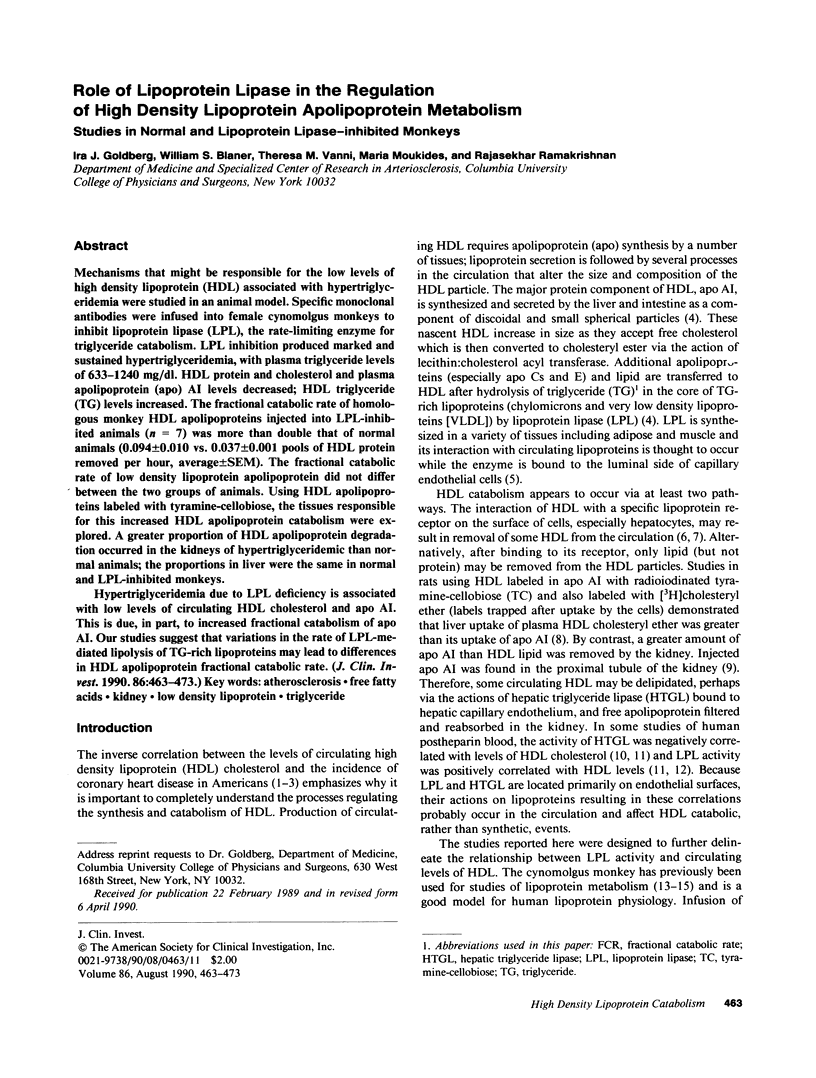
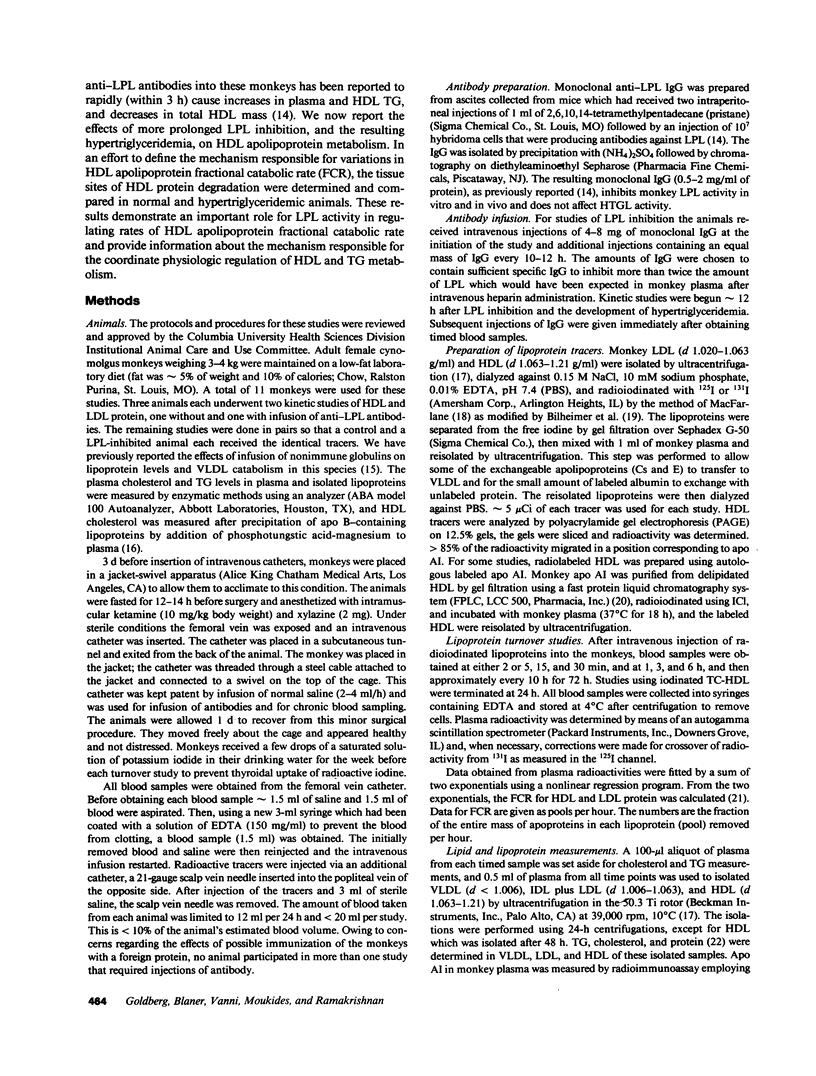
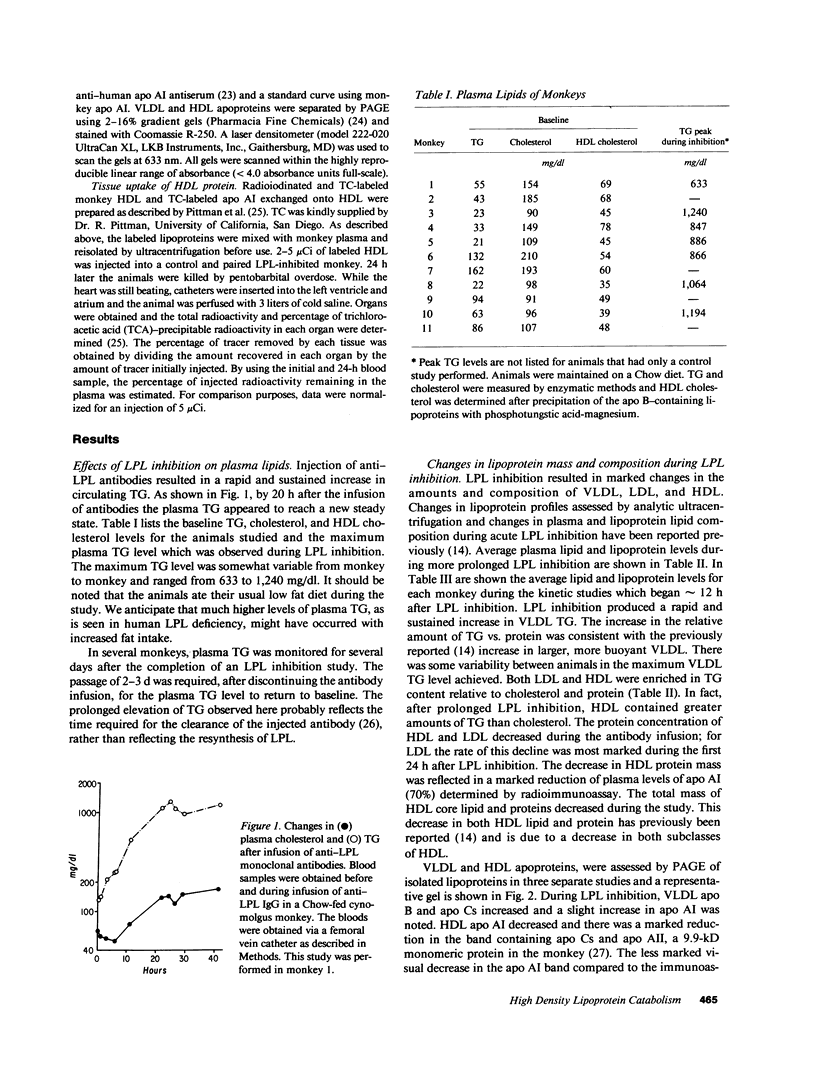
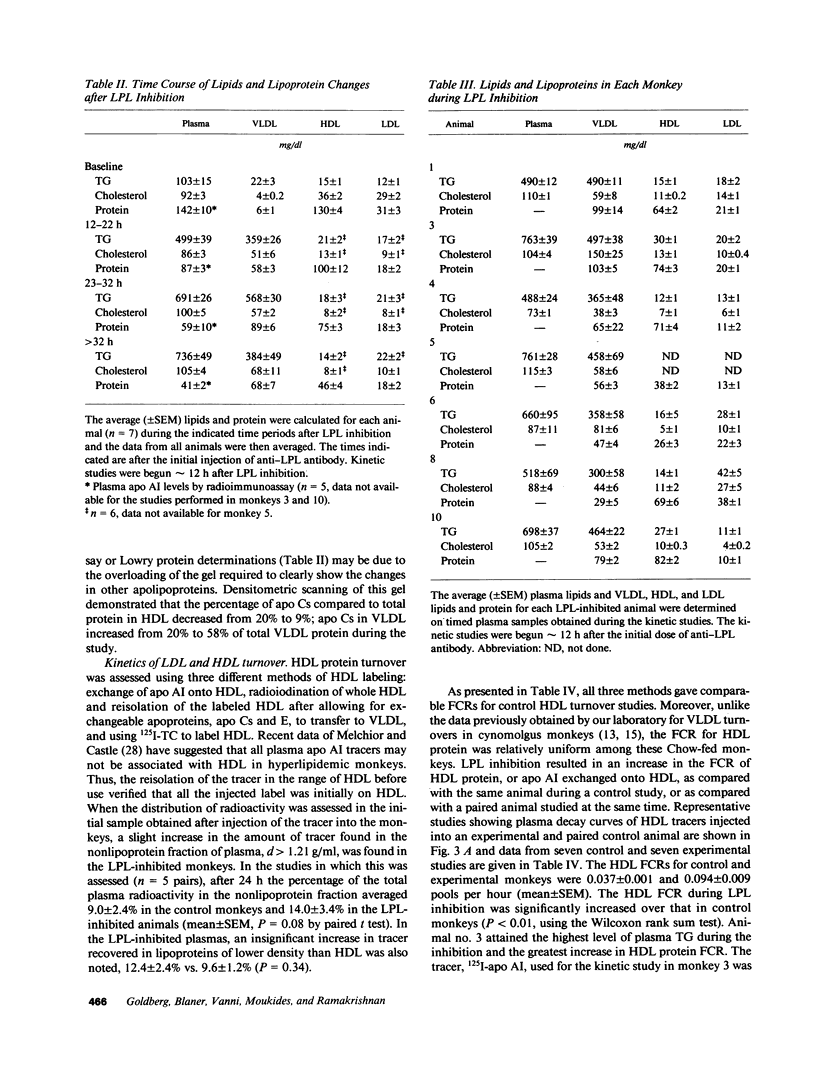
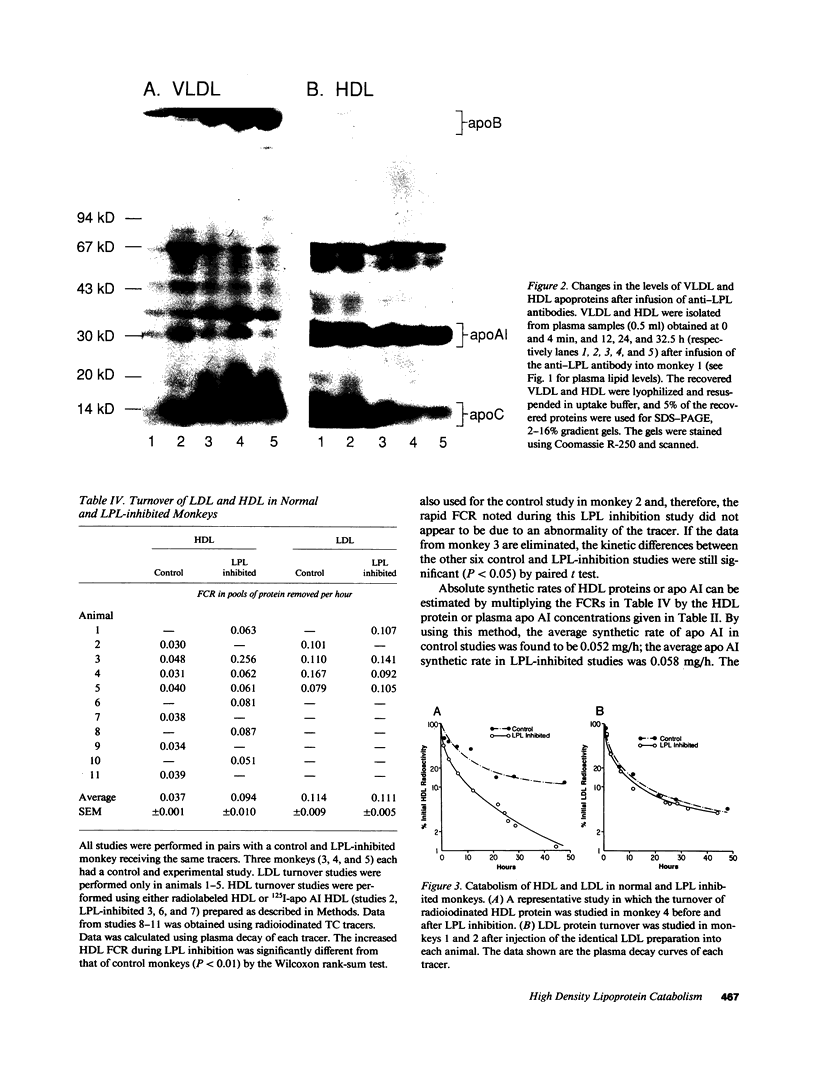
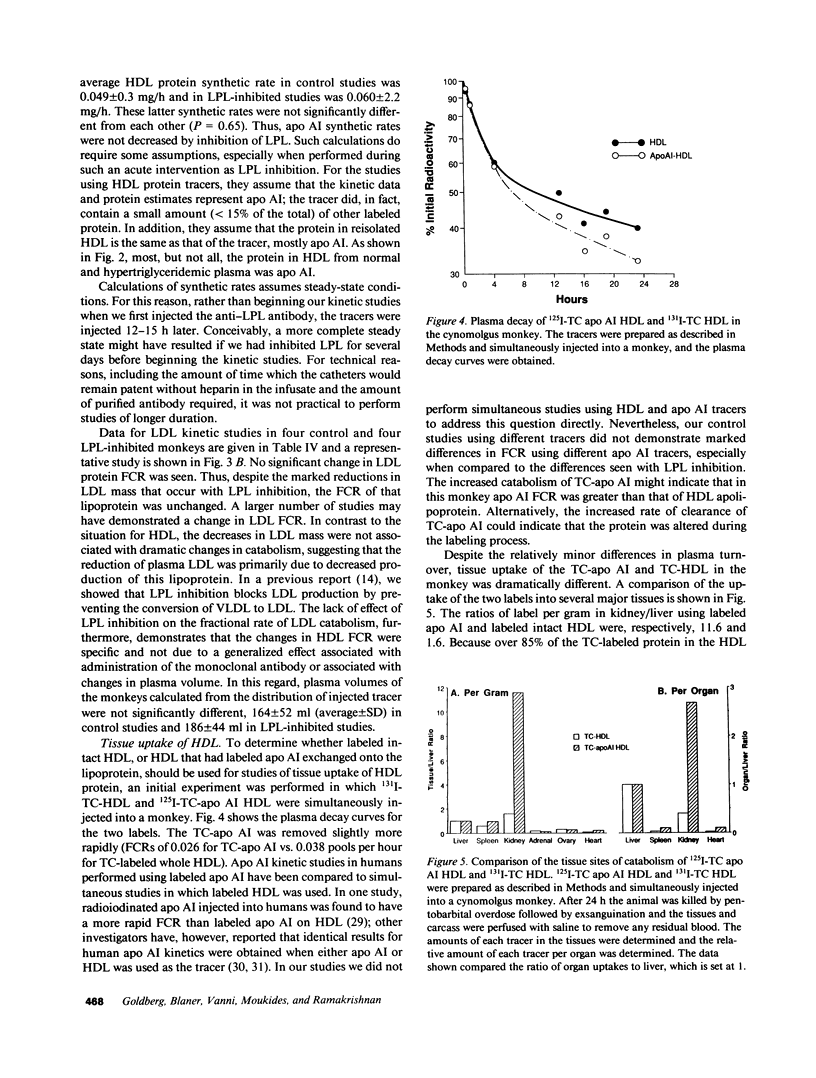
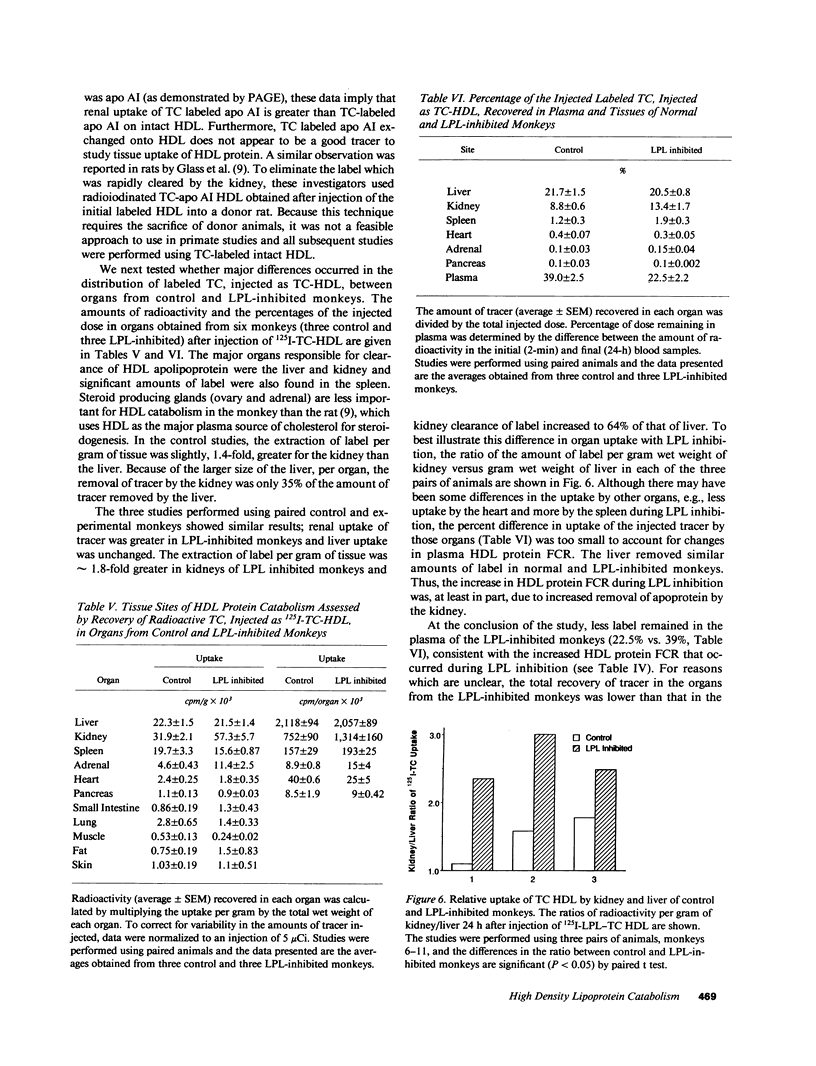
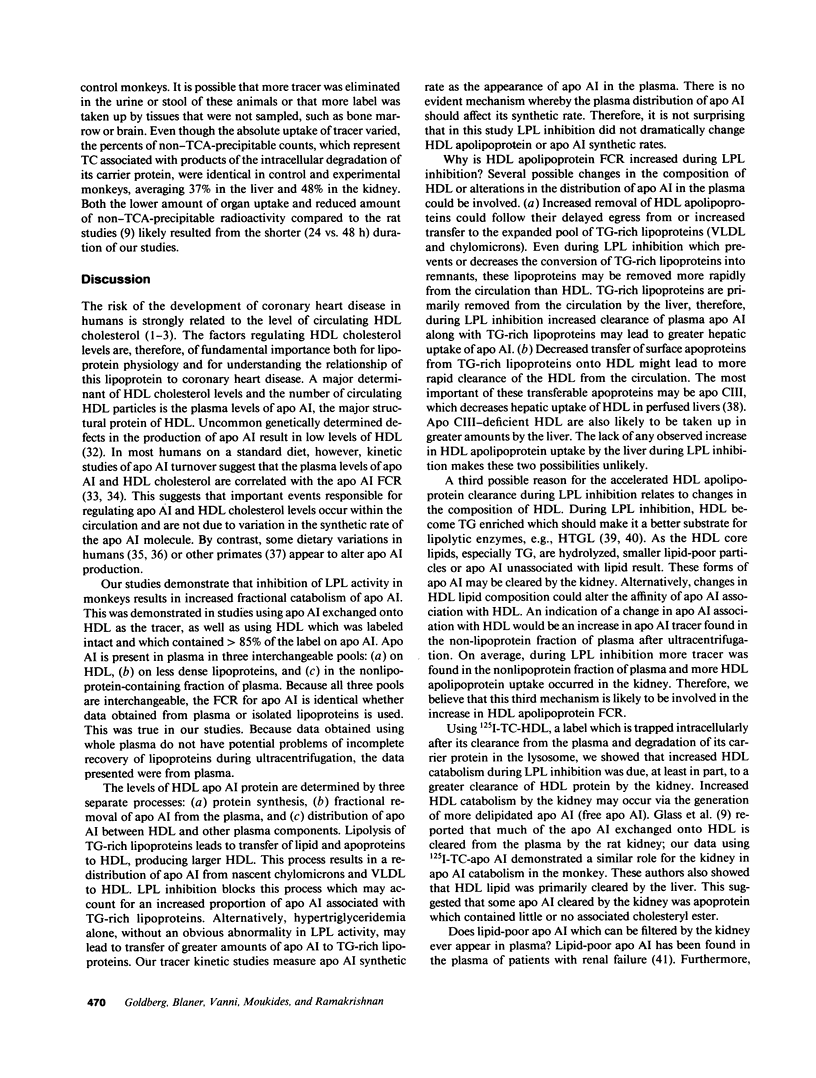
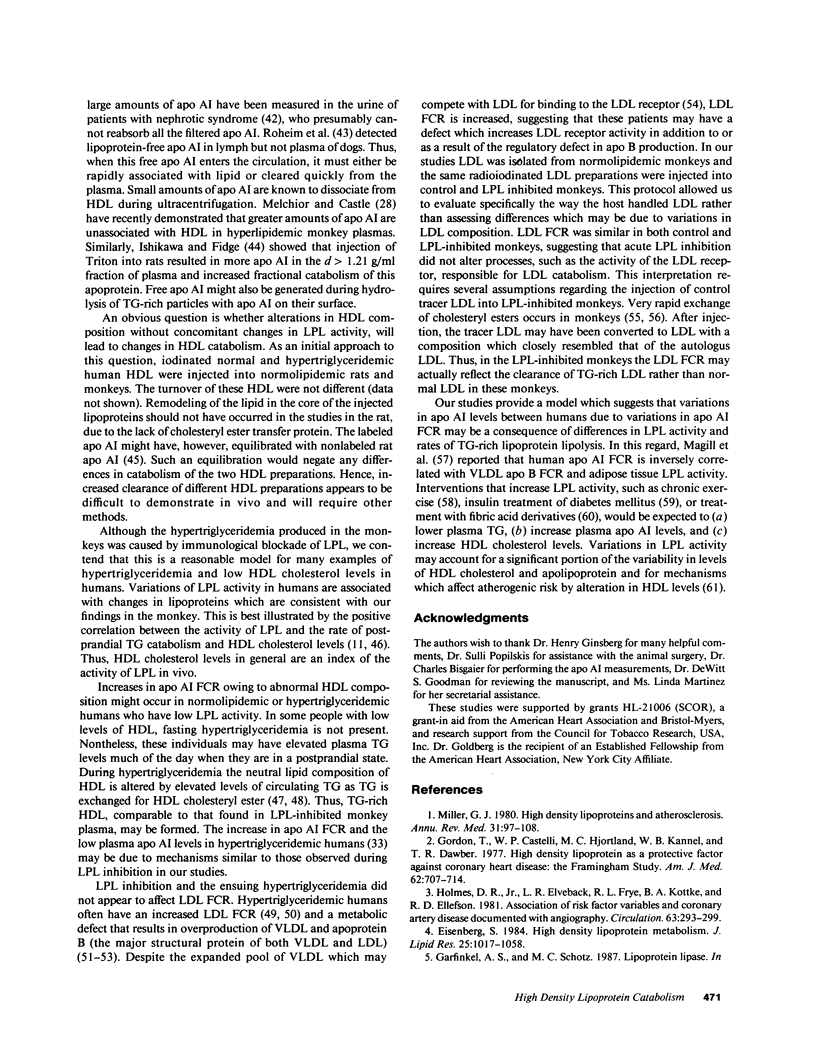
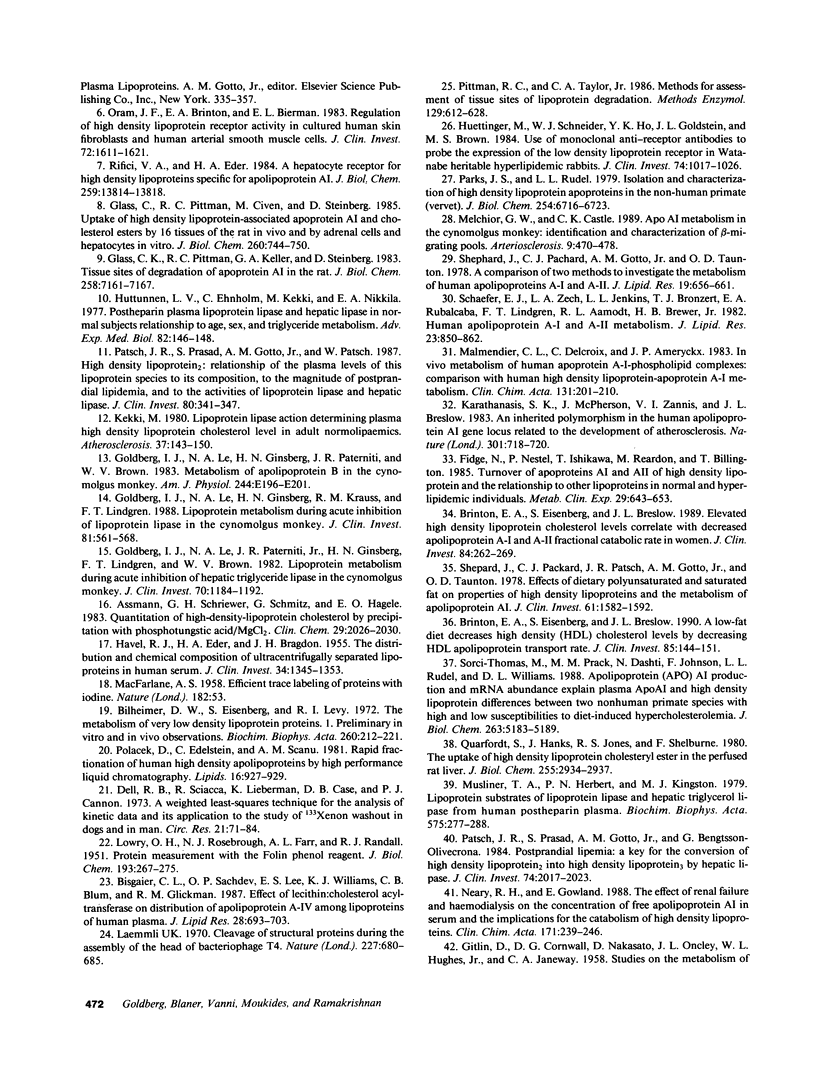
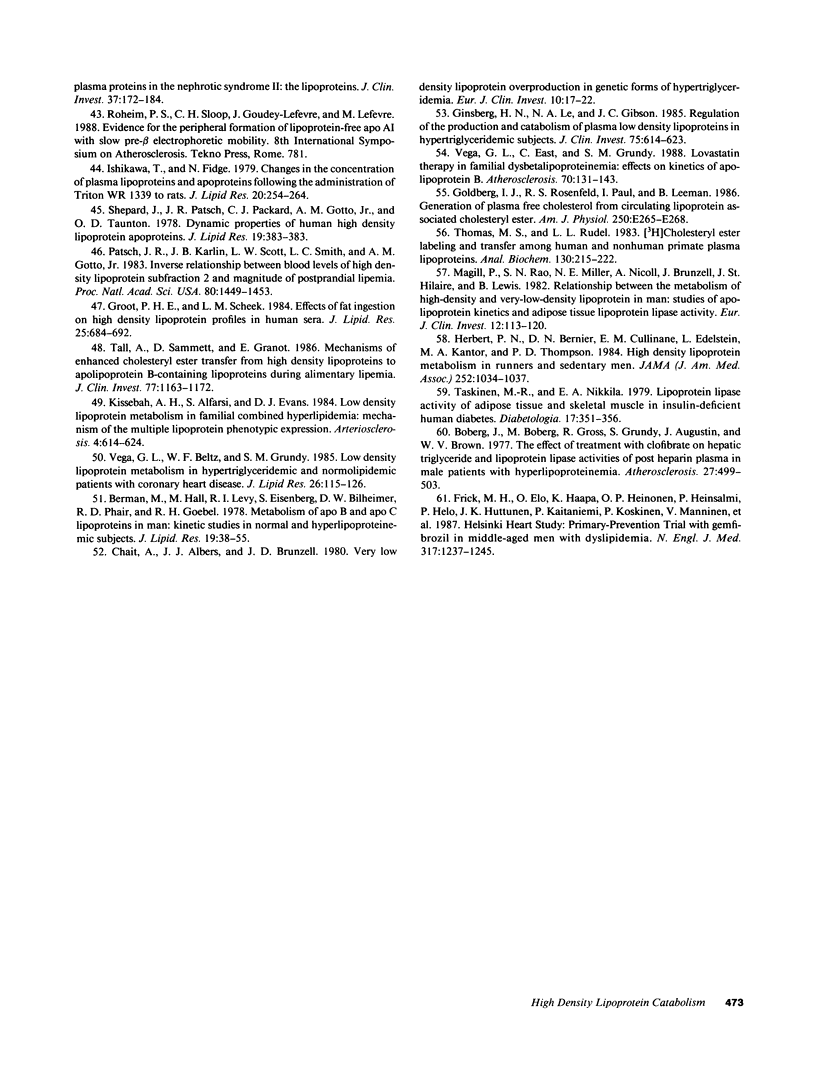
Images in this article
Selected References
These references are in PubMed. This may not be the complete list of references from this article.
- Assmann G., Schriewer H., Schmitz G., Hägele E. O. Quantification of high-density-lipoprotein cholesterol by precipitation with phosphotungstic acid/MgCl2. Clin Chem. 1983 Dec;29(12):2026–2030. [PubMed] [Google Scholar]
- Berman M., Hall M., 3rd, Levy R. I., Eisenberg S., Bilheimer D. W., Phair R. D., Goebel R. H. Metabolsim of apoB and apoC lipoproteins in man: kinetic studies in normal and hyperlipoproteininemic subjects. J Lipid Res. 1978 Jan;19(1):38–56. [PubMed] [Google Scholar]
- Bilheimer D. W., Eisenberg S., Levy R. I. The metabolism of very low density lipoprotein proteins. I. Preliminary in vitro and in vivo observations. Biochim Biophys Acta. 1972 Feb 21;260(2):212–221. doi: 10.1016/0005-2760(72)90034-3. [DOI] [PubMed] [Google Scholar]
- Bisgaier C. L., Sachdev O. P., Lee E. S., Williams K. J., Blum C. B., Glickman R. M. Effect of lecithin:cholesterol acyltransferase on distribution of apolipoprotein A-IV among lipoproteins of human plasma. J Lipid Res. 1987 Jun;28(6):693–703. [PubMed] [Google Scholar]
- Boberg J., Boberg M., Gross R., Grundy S., Augustin J., Brown V. The effect of treatment with clofibrate on hepatic triglyceride and lipoprotein lipase activities of post heparin plasma in male patients with hyperlipoproteinemia. Atherosclerosis. 1977 Aug;27(4):499–503. doi: 10.1016/0021-9150(77)90168-x. [DOI] [PubMed] [Google Scholar]
- Brinton E. A., Eisenberg S., Breslow J. L. A low-fat diet decreases high density lipoprotein (HDL) cholesterol levels by decreasing HDL apolipoprotein transport rates. J Clin Invest. 1990 Jan;85(1):144–151. doi: 10.1172/JCI114405. [DOI] [PMC free article] [PubMed] [Google Scholar]
- Brinton E. A., Eisenberg S., Breslow J. L. Elevated high density lipoprotein cholesterol levels correlate with decreased apolipoprotein A-I and A-II fractional catabolic rate in women. J Clin Invest. 1989 Jul;84(1):262–269. doi: 10.1172/JCI114149. [DOI] [PMC free article] [PubMed] [Google Scholar]
- Chait A., Albers J. J., Brunzell J. D. Very low density lipoprotein overproduction in genetic forms of hypertriglyceridaemia. Eur J Clin Invest. 1980 Feb;10(1):17–22. doi: 10.1111/j.1365-2362.1980.tb00004.x. [DOI] [PubMed] [Google Scholar]
- Dell R. B., Sciacca R., Lieberman K., Case D. B., Cannon P. J. A weighted least-squares technique for the analysis of kinetic data and its application to the study of renal xenon washout in dogs and man. Circ Res. 1973 Jan;32(1):71–84. doi: 10.1161/01.res.32.1.71. [DOI] [PubMed] [Google Scholar]
- Eisenberg S. High density lipoprotein metabolism. J Lipid Res. 1984 Oct;25(10):1017–1058. [PubMed] [Google Scholar]
- Fidge N., Nestel P., Ishikawa T., Reardon M., Billington T. Turnover of apoproteins A-I and A-II of high density lipoprotein and the relationship to other lipoproteins in normal and hyperlipidemic individuals. Metabolism. 1980 Jul;29(7):643–653. doi: 10.1016/0026-0495(80)90109-2. [DOI] [PubMed] [Google Scholar]
- Frick M. H., Elo O., Haapa K., Heinonen O. P., Heinsalmi P., Helo P., Huttunen J. K., Kaitaniemi P., Koskinen P., Manninen V. Helsinki Heart Study: primary-prevention trial with gemfibrozil in middle-aged men with dyslipidemia. Safety of treatment, changes in risk factors, and incidence of coronary heart disease. N Engl J Med. 1987 Nov 12;317(20):1237–1245. doi: 10.1056/NEJM198711123172001. [DOI] [PubMed] [Google Scholar]
- GITLIN D., CORNWELL D. G., NAKASATO D., ONCLEY J. L., HUGHES W. L., Jr, JANEWAY C. A. Studies on the metabolism of plasma proteins in the nephrotic syndrome. II. The lipoproteins. J Clin Invest. 1958 Feb;37(2):172–184. doi: 10.1172/JCI103596. [DOI] [PMC free article] [PubMed] [Google Scholar]
- Ginsberg H. N., Le N. A., Gibson J. C. Regulation of the production and catabolism of plasma low density lipoproteins in hypertriglyceridemic subjects. Effect of weight loss. J Clin Invest. 1985 Feb;75(2):614–623. doi: 10.1172/JCI111739. [DOI] [PMC free article] [PubMed] [Google Scholar]
- Glass C. K., Pittman R. C., Keller G. A., Steinberg D. Tissue sites of degradation of apoprotein A-I in the rat. J Biol Chem. 1983 Jun 10;258(11):7161–7167. [PubMed] [Google Scholar]
- Glass C., Pittman R. C., Civen M., Steinberg D. Uptake of high-density lipoprotein-associated apoprotein A-I and cholesterol esters by 16 tissues of the rat in vivo and by adrenal cells and hepatocytes in vitro. J Biol Chem. 1985 Jan 25;260(2):744–750. [PubMed] [Google Scholar]
- Goldberg I. J., Le N. A., Ginsberg H. N., Krauss R. M., Lindgren F. T. Lipoprotein metabolism during acute inhibition of lipoprotein lipase in the cynomolgus monkey. J Clin Invest. 1988 Feb;81(2):561–568. doi: 10.1172/JCI113354. [DOI] [PMC free article] [PubMed] [Google Scholar]
- Goldberg I. J., Le N. A., Ginsberg H. N., Paterniti J. R., Jr, Brown W. V. Metabolism of apoprotein B in cynomolgus monkey: evidence for independent production of low-density lipoprotein apoprotein B. Am J Physiol. 1983 Feb;244(2):E196–E201. doi: 10.1152/ajpendo.1983.244.2.E196. [DOI] [PubMed] [Google Scholar]
- Goldberg I. J., Le N. A., Paterniti J. R., Jr, Ginsberg H. N., Lindgren F. T., Brown W. V. Lipoprotein metabolism during acute inhibition of hepatic triglyceride lipase in the cynomolgus monkey. J Clin Invest. 1982 Dec;70(6):1184–1192. doi: 10.1172/JCI110717. [DOI] [PMC free article] [PubMed] [Google Scholar]
- Goldberg I. J., Rosenfeld R. S., Paul I., Leeman B. Generation of plasma free cholesterol from circulating lipoprotein-associated cholesteryl ester. Am J Physiol. 1986 Mar;250(3 Pt 1):E265–E268. doi: 10.1152/ajpendo.1986.250.3.E265. [DOI] [PubMed] [Google Scholar]
- Gordon T., Castelli W. P., Hjortland M. C., Kannel W. B., Dawber T. R. High density lipoprotein as a protective factor against coronary heart disease. The Framingham Study. Am J Med. 1977 May;62(5):707–714. doi: 10.1016/0002-9343(77)90874-9. [DOI] [PubMed] [Google Scholar]
- Groot P. H., Scheek L. M. Effects of fat ingestion on high density lipoprotein profiles in human sera. J Lipid Res. 1984 Jul;25(7):684–692. [PubMed] [Google Scholar]
- HAVEL R. J., EDER H. A., BRAGDON J. H. The distribution and chemical composition of ultracentrifugally separated lipoproteins in human serum. J Clin Invest. 1955 Sep;34(9):1345–1353. doi: 10.1172/JCI103182. [DOI] [PMC free article] [PubMed] [Google Scholar]
- Herbert P. N., Bernier D. N., Cullinane E. M., Edelstein L., Kantor M. A., Thompson P. D. High-density lipoprotein metabolism in runners and sedentary men. JAMA. 1984 Aug 24;252(8):1034–1037. [PubMed] [Google Scholar]
- Holmes D. R., Jr, Elveback L. R., Frye R. L., Kottke B. A., Ellefson R. D. Association of risk factor variables and coronary artery disease documented with angiography. Circulation. 1981 Feb;63(2):293–299. doi: 10.1161/01.cir.63.2.293. [DOI] [PubMed] [Google Scholar]
- Huettinger M., Schneider W. J., Ho Y. K., Goldstein J. L., Brown M. S. Use of monoclonal anti-receptor antibodies to probe the expression of the low density lipoprotein receptor in tissues of normal and Watanabe heritable hyperlipidemic rabbits. J Clin Invest. 1984 Sep;74(3):1017–1026. doi: 10.1172/JCI111469. [DOI] [PMC free article] [PubMed] [Google Scholar]
- Huttunen J. K., Ehnholm C., Kekki M., Nikkilä E. A. Postheparin plasma lipoprotein lipase and hepatic lipase in normal human subjects: relationship to age, sex and triglyceride metabolism. Adv Exp Med Biol. 1977;82:146–148. doi: 10.1007/978-1-4613-4220-5_22. [DOI] [PubMed] [Google Scholar]
- Ishikawa T., Fidge N. Changes in the concentration of plasma lipoproteins and apoproteins following the administration of Triton WR 1339 to rats. J Lipid Res. 1979 Feb;20(2):254–264. [PubMed] [Google Scholar]
- Karathanasis S. K., Norum R. A., Zannis V. I., Breslow J. L. An inherited polymorphism in the human apolipoprotein A-I gene locus related to the development of atherosclerosis. Nature. 1983 Feb 24;301(5902):718–720. doi: 10.1038/301718a0. [DOI] [PubMed] [Google Scholar]
- Kekki M. Lipoprotein-lipase action determining plasma high density lipoprotein cholesterol level in adult normolipaemics. Atherosclerosis. 1980 Sep;37(1):143–150. doi: 10.1016/0021-9150(80)90102-1. [DOI] [PubMed] [Google Scholar]
- Kissebah A. H., Alfarsi S., Evans D. J. Low density lipoprotein metabolism in familial combined hyperlipidemia. Mechanism of the multiple lipoprotein phenotypic expression. Arteriosclerosis. 1984 Nov-Dec;4(6):614–624. doi: 10.1161/01.atv.4.6.614. [DOI] [PubMed] [Google Scholar]
- LOWRY O. H., ROSEBROUGH N. J., FARR A. L., RANDALL R. J. Protein measurement with the Folin phenol reagent. J Biol Chem. 1951 Nov;193(1):265–275. [PubMed] [Google Scholar]
- Laemmli U. K. Cleavage of structural proteins during the assembly of the head of bacteriophage T4. Nature. 1970 Aug 15;227(5259):680–685. doi: 10.1038/227680a0. [DOI] [PubMed] [Google Scholar]
- Magill P., Rao S. N., Miller N. E., Nicoll A., Brunzell J., St Hilaire J., Lewis B. Relationships between the metabolism of high-density and very-low-density lipoproteins in man: studies of apolipoprotein kinetics and adipose tissue lipoprotein lipase activity. Eur J Clin Invest. 1982 Apr;12(2):113–120. doi: 10.1111/j.1365-2362.1982.tb00947.x. [DOI] [PubMed] [Google Scholar]
- Malmendier C. L., Delcroix C., Ameryckx J. P. In vivo metabolism of human apoprotein A-I-phospholipid complexes. Comparison with human high density lipoprotein-apoprotein A-I metabolism. Clin Chim Acta. 1983 Jul 15;131(3):201–210. doi: 10.1016/0009-8981(83)90089-x. [DOI] [PubMed] [Google Scholar]
- Melchior G. W., Castle C. K. Apolipoprotein A-I metabolism in cynomolgus monkey. Identification and characterization of beta-migrating pools. Arteriosclerosis. 1989 Jul-Aug;9(4):470–478. doi: 10.1161/01.atv.9.4.470. [DOI] [PubMed] [Google Scholar]
- Miller G. J. High density lipoproteins and atherosclerosis. Annu Rev Med. 1980;31:97–108. doi: 10.1146/annurev.me.31.020180.000525. [DOI] [PubMed] [Google Scholar]
- Musliner T. A., Herbert P. N., Kingston M. J. Lipoprotein substrates of lipoprotein lipase and hepatic triacylglycerol lipase from human post-heparin plasma. Biochim Biophys Acta. 1979 Nov 21;575(2):277–288. doi: 10.1016/0005-2760(79)90029-8. [DOI] [PubMed] [Google Scholar]
- Neary R. H., Gowland E. The effect of renal failure and haemodialysis on the concentration of free apolipoprotein A-1 in serum and the implications for the catabolism of high-density lipoproteins. Clin Chim Acta. 1988 Feb 15;171(2-3):239–245. doi: 10.1016/0009-8981(88)90149-0. [DOI] [PubMed] [Google Scholar]
- Oram J. F., Brinton E. A., Bierman E. L. Regulation of high density lipoprotein receptor activity in cultured human skin fibroblasts and human arterial smooth muscle cells. J Clin Invest. 1983 Nov;72(5):1611–1621. doi: 10.1172/JCI111120. [DOI] [PMC free article] [PubMed] [Google Scholar]
- Parks J. S., Rudel L. L. Isolation and characterization of high density lipoprotein apoproteins in the non-human primate (vervet). J Biol Chem. 1979 Jul 25;254(14):6716–6723. [PubMed] [Google Scholar]
- Patsch J. R., Karlin J. B., Scott L. W., Smith L. C., Gotto A. M., Jr Inverse relationship between blood levels of high density lipoprotein subfraction 2 and magnitude of postprandial lipemia. Proc Natl Acad Sci U S A. 1983 Mar;80(5):1449–1453. doi: 10.1073/pnas.80.5.1449. [DOI] [PMC free article] [PubMed] [Google Scholar]
- Patsch J. R., Prasad S., Gotto A. M., Jr, Bengtsson-Olivecrona G. Postprandial lipemia. A key for the conversion of high density lipoprotein2 into high density lipoprotein3 by hepatic lipase. J Clin Invest. 1984 Dec;74(6):2017–2023. doi: 10.1172/JCI111624. [DOI] [PMC free article] [PubMed] [Google Scholar]
- Patsch J. R., Prasad S., Gotto A. M., Jr, Patsch W. High density lipoprotein2. Relationship of the plasma levels of this lipoprotein species to its composition, to the magnitude of postprandial lipemia, and to the activities of lipoprotein lipase and hepatic lipase. J Clin Invest. 1987 Aug;80(2):341–347. doi: 10.1172/JCI113078. [DOI] [PMC free article] [PubMed] [Google Scholar]
- Pittman R. C., Taylor C. A., Jr Methods for assessment of tissue sites of lipoprotein degradation. Methods Enzymol. 1986;129:612–628. doi: 10.1016/0076-6879(86)29094-1. [DOI] [PubMed] [Google Scholar]
- Polacek D., Edelstein C., Scanu A. M. Rapid fractionation of human high density apolipoproteins by high performance liquid chromatography. Lipids. 1981 Dec;16(12):927–929. doi: 10.1007/BF02534999. [DOI] [PubMed] [Google Scholar]
- Quarfordt S., Hanks J., Jones R. S., Shelburne F. The uptake of high density lipoprotein cholesteryl ester in the perfused rat liver. J Biol Chem. 1980 Apr 10;255(7):2934–2937. [PubMed] [Google Scholar]
- Rifici V. A., Eder H. A. A hepatocyte receptor for high-density lipoproteins specific for apolipoprotein A-I. J Biol Chem. 1984 Nov 25;259(22):13814–13818. [PubMed] [Google Scholar]
- Schaefer E. J., Zech L. A., Jenkins L. L., Bronzert T. J., Rubalcaba E. A., Lindgren F. T., Aamodt R. L., Brewer H. B., Jr Human apolipoprotein A-I and A-II metabolism. J Lipid Res. 1982 Aug;23(6):850–862. [PubMed] [Google Scholar]
- Shepherd J., Packard C. J., Gotto A. M., Jr, Taunton O. D. A comparison of two methods to investigate the metabolism of human apolipoproteins A-I and and A-II. J Lipid Res. 1978 Jul;19(5):656–661. [PubMed] [Google Scholar]
- Shepherd J., Packard C. J., Patsch J. R., Gotto A. M., Jr, Taunton O. D. Effects of dietary polyunsaturated and saturated fat on the properties of high density lipoproteins and the metabolism of apolipoprotein A-I. J Clin Invest. 1978 Jun;61(6):1582–1592. doi: 10.1172/JCI109078. [DOI] [PMC free article] [PubMed] [Google Scholar]
- Shepherd J., Patsch J. R., Packard C. J., Gotto A. M., Jr, Taunton O. D. Dynamic properties of human high density lipoprotein apoproteins. J Lipid Res. 1978 Mar;19(3):383–389. [PubMed] [Google Scholar]
- Sorci-Thomas M., Prack M. M., Dashti N., Johnson F., Rudel L. L., Williams D. L. Apolipoprotein (apo) A-I production and mRNA abundance explain plasma apoA-I and high density lipoprotein differences between two nonhuman primate species with high and low susceptibilities to diet-induced hypercholesterolemia. J Biol Chem. 1988 Apr 15;263(11):5183–5189. [PubMed] [Google Scholar]
- Tall A., Sammett D., Granot E. Mechanisms of enhanced cholesteryl ester transfer from high density lipoproteins to apolipoprotein B-containing lipoproteins during alimentary lipemia. J Clin Invest. 1986 Apr;77(4):1163–1172. doi: 10.1172/JCI112417. [DOI] [PMC free article] [PubMed] [Google Scholar]
- Taskinen M. R., Nikkilä E. A. Lipoprotein lipase activity of adipose tissue and skeletal muscle in insulin-deficient human diabetes. Relation to high-density and very-low-density lipoproteins and response to treatment. Diabetologia. 1979 Dec;17(6):351–356. doi: 10.1007/BF01236268. [DOI] [PubMed] [Google Scholar]
- Thomas M. S., Rudel L. L. [3H]Cholesteryl ester labeling and transfer among human and nonhuman primate plasma lipoproteins. Anal Biochem. 1983 Apr 1;130(1):215–222. doi: 10.1016/0003-2697(83)90672-3. [DOI] [PubMed] [Google Scholar]
- Vega G. L., Beltz W. F., Grundy S. M. Low density lipoprotein metabolism in hypertriglyceridemic and normolipidemic patients with coronary heart disease. J Lipid Res. 1985 Jan;26(1):115–126. [PubMed] [Google Scholar]
- Vega G. L., East C., Grundy S. M. Lovastatin therapy in familial dysbetalipoproteinemia: effects on kinetics of apolipoprotein B. Atherosclerosis. 1988 Mar;70(1-2):131–143. doi: 10.1016/0021-9150(88)90107-4. [DOI] [PubMed] [Google Scholar]



